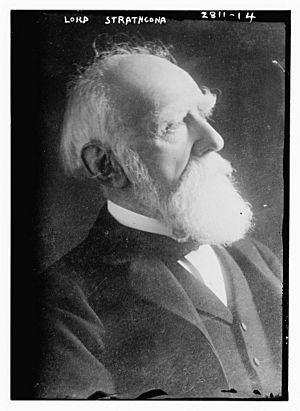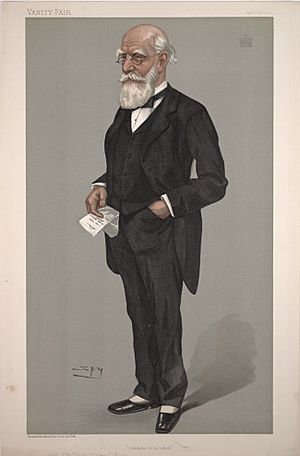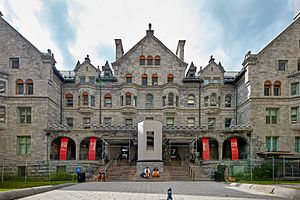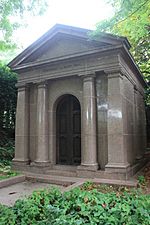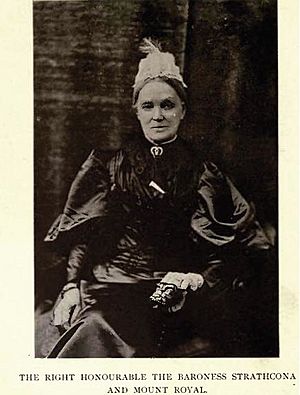Donald Smith, 1st Baron Strathcona and Mount Royal facts for kids
Quick facts for kids
The Lord Strathcona and Mount Royal
|
|
|---|---|
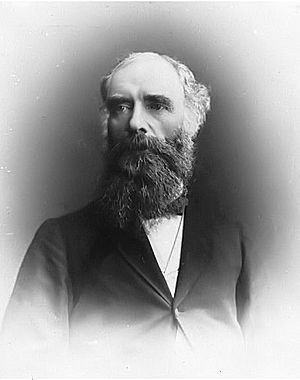 |
|
| Canadian High Commissioner to the United Kingdom | |
| In office 1896–1914 |
|
| Prime Minister | Charles Tupper Wilfrid Laurier Robert Borden |
| Preceded by | Charles Tupper |
| Succeeded by | George Perley |
| Member of Parliament for Montreal West |
|
| In office 22 February 1887 – 22 June 1896 |
|
| Preceded by | Matthew Hamilton Gault |
| Succeeded by | District abolished |
| Member of Parliament for Selkirk |
|
| In office 2 March 1871 – 13 May 1880 |
|
| Preceded by | District established |
| Succeeded by | Thomas Scott |
| More... | |
| Personal details | |
| Born |
Donald Alexander Smith
6 August 1820 Forres, Scotland |
| Died | 21 January 1914 (aged 93) London, England |
| Resting place | Highgate Cemetery, London |
| Citizenship | British subject |
| Spouse |
Isabella Sophia Hardisty
(m. 1853; died 1913) |
| Children | Margaret Howard, 2nd Baroness Strathcona and Mount Royal |
| Residences | 28 Grosvenor Square, London |
| Occupation | Diplomat, businessman |
| Known for | Driving the CPR's Last Spike |
| Awards | Albert Medal (1912) |
| Signature | |
Donald Alexander Smith, 1st Baron Strathcona and Mount Royal (born August 6, 1820 – died January 21, 1914) was a very important Scottish-born Canadian businessman. He became famous for building parts of the British Empire and for his generous donations to many causes.
He was a leader at the Hudson's Bay Company, which was a big fur trading business. He also became the president of the Bank of Montreal. With his cousin, Lord Mount Stephen, he helped create the Canadian Pacific Railway. This railway connected Canada from east to west.
Donald Smith also worked in politics. He was a member of the Legislative Assembly of Manitoba and later represented Montreal in the House of Commons of Canada. From 1896 to 1914, he was Canada's top representative in the United Kingdom, known as the Canadian High Commissioner to the United Kingdom.
He was also the head of Burmah Oil and the Anglo-Persian Oil Company. He served as the leader (Chancellor) of McGill University and the University of Aberdeen. King Edward VII even called him "Uncle Donald"!
Donald Smith gave away a lot of money during his life. He helped build the Royal Victoria Hospital in Montreal. He also supported McGill University a lot. He even started a program called the Donalda Program to help Canadian women get a higher education. For this, he built the Royal Victoria College in Montreal. He also created the Lord Strathcona Medal to encourage physical training and patriotism in young Canadians.
Contents
Early Life and the Hudson's Bay Company
Donald Smith was born on August 6, 1820, in Forres, Scotland. His father was a saddler. Donald was also a cousin of the famous Grant brothers, who were known for their kindness. His mother's brother, John Stuart, was an explorer and a Chief Factor for the Hudson's Bay Company.
When Donald was 16, he started training to be a lawyer. But at 18, he decided to follow his uncle's path. He chose to work for the Hudson's Bay Company (HBC) and sailed to Montreal in 1838.
Smith started as a clerk for the HBC in 1842. He worked in Labrador for many years, managing the fur trade and salmon fishing. In 1862, he became the Chief Factor for the Labrador area. He impressed the HBC directors in London and was promoted to Commissioner of the Montreal department in 1868.
In 1869, the Canadian government asked Smith to help with problems in the Red River Colony (now part of Manitoba). He traveled there and talked with Louis Riel, who was leading a group of people resisting the government. Smith's efforts helped calm things down and led to formal talks. He returned to Ottawa and reported on the situation, which made him well-known. He was then made President of the HBC's Council for the Northern Department, which meant he was in charge of the Northwest Territories.
Political Career
In 1870, Donald Smith was elected to the Manitoba legislature. He was also elected to the House of Commons of Canada in 1871 for the area of Selkirk. This meant he served in both provincial and federal governments at the same time, which was allowed back then.
Smith was an "Independent Conservative" in federal politics. He often defended the interests of the Hudson's Bay Company and the people of Manitoba. He helped create the Bank of Manitoba.
In 1873, Smith disagreed with Prime Minister John A. Macdonald and voted against his government. This helped lead to Macdonald's government being defeated. Smith continued to be an independent politician.
He left the provincial legislature in 1874. He was re-elected to the federal parliament in 1874 and 1878. His business interests grew, and he eventually left his role as land commissioner for the HBC in 1879.
Building the Canadian Pacific Railway
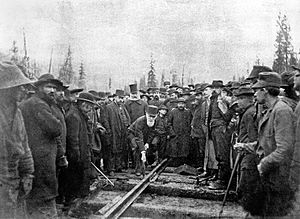
Donald Smith became very interested in railways. In 1879, he became a director of a railway company in the United States. He was a key person in creating the Canadian Pacific Railway (CPR). Even though he had some disagreements with Prime Minister Macdonald, he joined the CPR's board of directors in 1883.
A very famous moment in Canadian history happened when Smith drove the last spike to finish the Canadian Pacific Railway. This happened on November 7, 1885, in Craigellachie, British Columbia. This railway connected Canada from coast to coast, which was a huge achievement.
Smith became very rich from his investments. He was involved in many businesses in Canada and the United States. He joined the board of the Bank of Montreal in 1872 and became its president in 1887. He also remained a very important figure at the Hudson's Bay Company, becoming its Governor in 1889.
Later Political Life and High Commissioner
Smith was re-elected to the Canadian House of Commons in 1887 and 1891, representing Montreal West. He continued to be an "Independent Conservative."
In 1896, Prime Minister Charles Tupper appointed Donald Smith as the High Commissioner to the United Kingdom. This meant he was Canada's main representative in London. He held this important job until his death in 1914.
On August 23, 1897, he was given the special title of Baron Strathcona and Mount Royal. This made him a Lord in the United Kingdom. He was also given other important honors for his work.
Lord Strathcona helped encourage people from Eastern Europe to move to the Canadian prairies. He also created a private unit of Canadian soldiers called Strathcona's Horse, which fought in the Second Boer War. He was a strong supporter of the British Empire. He also helped create the Anglo-Persian Oil Company and became its chairman.
He was also the Lord Rector of the University of Aberdeen from 1899 to 1902.
Philanthropy and Legacy
Lord Strathcona was a very generous person. He gave large amounts of money to many organizations in Britain, Canada, and other places. His biggest donations were made with George Stephen to build the Royal Victoria Hospital in Montreal, which opened in 1893.
He also gave a lot of money to McGill University in Montreal. He helped start a college for women there in 1884, called the Royal Victoria College. He became the Chancellor of McGill in 1888 and stayed in that role until he died. He also gave money to Yale University and the new University of Birmingham.
In 1910, Lord Strathcona set up a fund of $500,000 to help young Canadians develop good citizenship and patriotism. This fund supports physical training, rifle shooting, and military drill, especially for groups like the Royal Canadian Army Cadets. The Lord Strathcona Medal is still awarded today to cadets who show outstanding performance.
Death and Resting Place
Lord Strathcona passed away in London in 1914. He was buried at Highgate Cemetery in London. He worked for the Hudson's Bay Company for 75 years, which is a record!
He had many homes, including one in Montreal's Golden Square Mile. He also bought estates in Scotland, like Glencoe House and the Island of Colonsay. He also leased Knebworth House in England. He had a large funeral at Westminster Abbey, but he chose to be buried next to his wife in Highgate Cemetery.
His obituary in The Times of London newspaper said that he became "one of the great outstanding figures of the Empire" even though he didn't start with any special advantages.
Family
In 1853, Donald Smith married Isabella Sophia Hardisty. She was the daughter of Richard Hardisty, who was also a Chief Trader for the Hudson's Bay Company. Isabella's mother had both Indigenous and Scottish heritage.
Lord and Lady Strathcona had one child, a daughter named Margaret Charlotte Smith. When her father passed away, she became Lady Strathcona. In 1888, she married Robert Jared Bliss Howard.
They had several children:
- Frances Margaret Palmer Howard
- Donald Sterling Palmer Howard, who became the 3rd Baron Strathcona and Mount Royal
- Robert Henry Palmer Howard
- Edith Mary Palmer Howard
- Sir Arthur Jared Palmer Howard
The family still owns the island of Colonsay in Scotland today.
Legacy
Lord Strathcona is remembered in many ways across Canada. Several buildings at McGill University in Montreal are named after him because he gave so much to the university. There is also a street named Strathcona Avenue in Westmount, a suburb of Montreal.
In Winnipeg, Manitoba, two streets in the downtown area, Donald Street and Smith Street, are named after him. There is also a Strathcona Street in the city's West End. In Alberta, the Calgary neighborhood of Strathcona Park and the Edmonton neighborhood of Strathcona are named for him. The area of Strathcona County in Alberta also carries his name.
In British Columbia, the Vancouver neighborhood of Strathcona is named after Lord Strathcona School, built in 1891. Mount Sir Donald in Glacier National Park is also named after him.
The town of Fort Smith in the Northwest Territories is named after Donald Smith. There is a beautiful stained glass window in Westminster Abbey in London that remembers him. His family crest is also displayed over the main entrance of Marischal College in Aberdeen, Scotland. Strathcona Park in Ottawa, built in 1907, is dedicated to him. The town of Transcona, Manitoba, gets part of its name from Lord Strathcona.
Lord Strathcona was even inducted into the Canadian Curling Hall of Fame in 1973!
Ships Named for Lord Strathcona
At least three ships were named after Lord Strathcona during his lifetime:
- The Strathcona, a wooden paddle steamer built in 1898 for the Hudson's Bay Company. It operated on the Pacific Northwest coast.
- The Strathcona, a steel cargo ship built in 1900 in Scotland. It sailed on the Great Lakes and was later used in the First World War, where it was sunk in 1917.
- The Lord Strathcona, a steel salvage tug built in 1902 in England. It helped with salvage operations in Canada until 1947.
A fourth ship, also named Lord Strathcona, was an ocean steamer built in 1915. It was sunk by a German submarine in 1942 during the Second World War.
Images for kids
-
Glencoe House, Scotland in 1905, built by Lord Strathcona in 1895
-
Colonsay House, purchased with the island by Lord Strathcona and still occupied by his descendants today
-
Knebworth House, leased by Lord Strathcona from 1899 until his death
See also
- Canadian peers and baronets
- Glencoe House
- Glencoe Lochan
- Golden Square Mile


